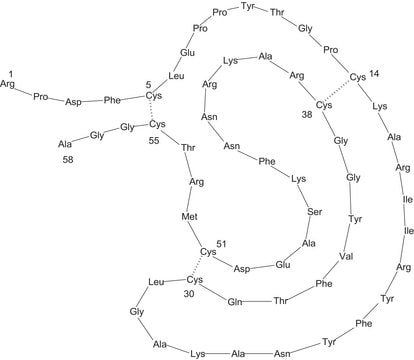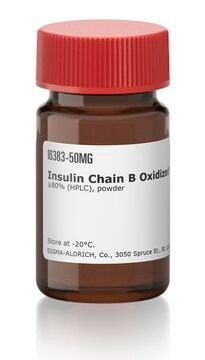10820
Aprotinin from bovine lung
lyophilized, ~80% (HPCE), crystalline (fine), white, ≥3500 U/mg
Synonym(s):
BPTI, Bovine pancreatic trypsin inhibitor, Trasylol, Trypsin inhibitor (basic)
About This Item
Recommended Products
biological source
bovine lung
Quality Level
assay
~80% (HPCE)
form
crystalline (fine)
quality
lyophilized
specific activity
≥3500 U/mg
mol wt
~6,500
technique(s)
electrophoresis: suitable
color
white
solubility
phosphate buffer: 5 mg/mL, clear, colorless (PH 7.6 (70 mm phosphate))
UniProt accession no.
storage temp.
2-8°C
InChI key
ZPNFWUPYTFPOJU-UHFFFAOYSA-N
Gene Information
cow ... PTI(404172)
Looking for similar products? Visit Product Comparison Guide
Application
Biochem/physiol Actions
Unit Definition
Storage Class
11 - Combustible Solids
wgk_germany
WGK 1
flash_point_f
Not applicable
flash_point_c
Not applicable
ppe
Eyeshields, Gloves, type N95 (US)
Certificates of Analysis (COA)
Search for Certificates of Analysis (COA) by entering the products Lot/Batch Number. Lot and Batch Numbers can be found on a product’s label following the words ‘Lot’ or ‘Batch’.
Already Own This Product?
Find documentation for the products that you have recently purchased in the Document Library.
Customers Also Viewed
Our team of scientists has experience in all areas of research including Life Science, Material Science, Chemical Synthesis, Chromatography, Analytical and many others.
Contact Technical Service










